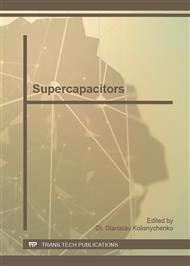p.3621
p.3626
p.3635
p.3641
p.3645
p.3649
p.3653
p.3658
p.3662
Activated Carbon Modified by Adhesion Promoter for Supercapacitor
Abstract:
In this study, we investigated a simple strategy by introducing a adhesion promoter into the electrode to improve decrease bonder content and the supercapacitor performance. The improved electrodes are characterized by scanning electron microscopy (SEM) and electrochemical measurements. According to the results, the treated activated carbon electrode retains good adhesion strength with smaller bonder content. The electrode prepared using activated carbon treated with the adhesion promoter and a bonder mass content of 7.0 % shows the best electrochemical performance. The specific capacitance reaches 347.5 F•g-1, whereas the internal resistance is 0.94 Ω.
Info:
Periodical:
Pages:
3645-3648
Citation:
Online since:
October 2011
Authors:
Price:
Сopyright:
© 2012 Trans Tech Publications Ltd. All Rights Reserved
Share:
Citation:



